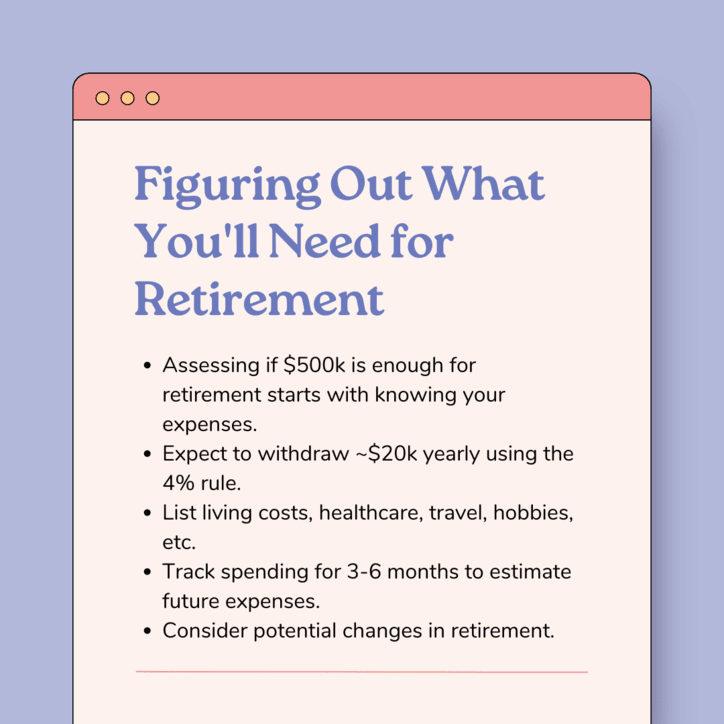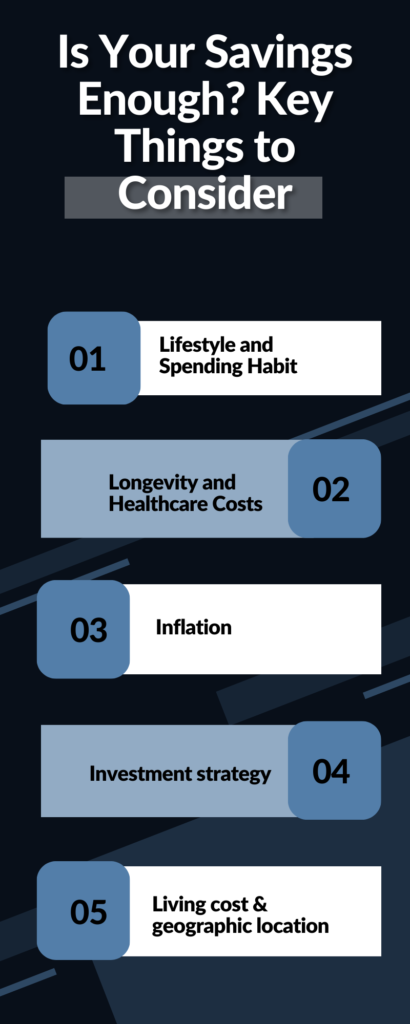Thinking about retirement can be exciting, but it also comes with financial questions. One common question is, “Can I retire on $500,000?” Well, the answer depends on a few things, and let’s explore them together to help you make the best decision for your retirement journey.
The short answer is retiring on $500,000 is possible whether you are in your 60s or an early retiree. But it requires thoughtful planning and can be challenging in its own way depending on various factors such as your spending habits, investment choices and lifestyle.
Retiring on $500k: Figuring Out What You’ll Need for Retirement
The first step in assessing whether $500,000 is sufficient for retirement is understanding your expected expenses. With $500k, you can expect to withdraw ~20k annually using the 4% rule.
List your expected expenses like essential living costs, healthcare expenses, travel, hobbies, and other discretionary spending. By having a clear picture of your anticipated yearly spending, you can better gauge if your retirement savings can sustain your desired lifestyle.
If you’re unsure where to start, try tracking your spending for at least three to six months. Check your credit card and bank statements. Your budget should include basic living expenses like housing, food, utilities, transportation, healthcare, hobbies, and travel. This will give you an idea of how much you’re currently spending and whether it’s likely to be similar during retirement.
Think also about whether any of your expenses might change in retirement. Some expenses might increase, like healthcare, while others could decrease or even disappear, like work-related costs.
Reviewing your credit card and bank statements might take effort, but it’s crucial. This way, you can see if the 500k you have will be enough to cover all your expenses and ensure you’re financially prepared for your future.
Here is the breakdown of example yearly expenses. Feel free to use this template as a starting point to calculate your expenses. If your expenses exceed 20k, look for ways to increase your income and/or reduce your expenses.
Housing
| Expense | Monthly | Annual |
| Mortgage or rent | 900 | 10,800 |
| Property tax | 0 | 0 |
| Strata/HOA fees | 0 | 0 |
| Home insurance | 0 | 0 |
| Home maintenance | 0 | 0 |
Transportation
| Expense | Monthly | Annual |
| Car insurance | 151 | 1,812 |
| Gas | 90 | 1,080 |
| Car maintenance | 0 | 230 |
| Bike maintenance | 0 | |
| Parking and tolls | 150 | 1,800 |
| Transit | 0 |
Food
| Expense | Monthly | Annual |
| Groceries | 200 | 2,400 |
| Eating out | 200 | 2,400 |
Utilities
| Expense | Monthly | Annual |
| Natural gas | 0 | 0 |
| Electricity | 107 | 1,284 |
| Water | 0 | 0 |
| Garbage | 0 | 0 |
| Internet | 20 | 240 |
| Home phone | 0 | 0 |
| Cell phones | 45 | 540 |
| Streaming entertainment | 0 | 0 |
Insurance and other essentials
| Expense | Monthly | Annual |
| Life and disability insurance | 0 | |
| Medical insurance | 102 | 1,224 |
| Out-of-pocket medical expenses | 500 | |
| Clothing and footwear | 100 | 1,200 |
| Personal care | 75 | 900 |
| Technology (essential items only) | 0 |

4% rule: How much money you can withdraw annually with 500k
One popular guideline used in retirement planning is the 4% rule.
According to this rule, you can withdraw 4% of your initial retirement savings in the first year of retirement and adjust that amount for inflation in subsequent years. Applying this rule to $500,000, you could potentially withdraw $20,000 in the first year. However, it’s essential to remember that this rule is not one-size-fits-all and requires careful consideration of individual circumstances.
The rule suggests that if you withdraw 4% of your savings in the first year of retirement and adjust it for inflation in the following years, your money should last about 30 years.
To determine how much money you need in your portfolio, you can estimate your yearly expenses and multiply that by 25. For example, if you spend $30,000 annually, you’ll need to save $750,000. If your expenses are $40,000, you’ll need to save $1 million.
So, If you have $500,000 in investment, keeping your yearly expenses below $20,000 is recommended to make it last. Staying within this budget will help ensure your retirement funds can support your lifestyle for longer.
Should I pull all of my money in a high-yield online savings account?
The 4% rule does not assume that all of your money is in a high-yield online savings account. Unless you have loads of money in the high-yield online savings account, relying solely on a savings account for retirement may not be sufficient to keep up with inflation and provide adequate income over the long term.
The rule is based on a diversified investment portfolio, which typically includes a mix of stocks, bonds, real estate, and other investments. The allocation may vary depending on the individual’s circumstances and risk tolerance.

Important factors to consider before knowing if 500k will be enough
Lifestyle and Spending Habit
If you have a modest lifestyle and can manage your expenses well, $500,000 might be sufficient. However, it might not be enough if you have expensive tastes, extensive travel plans, or costly hobbies.
In my case, I relatively have a simple lifestyle, but I enjoy traveling. Traveling (in my opinion) is a relatively expensive hobby. I prefer comfortable hotels over hostels when traveling, and I truly enjoy worry-free spending on my trips. Considering this, I doubted whether $500,000 would support my desired lifestyle, involving frequent travel and various activities.
Longevity and Healthcare Costs
Thinking how long you might live and how much healthcare could cost can be very helpful when planning your retirement.
As we age, healthcare expenses tend to increase, so you must include these costs when figuring out how much money you’ll need for retirement. These factors will help ensure your retirement funds last and cover your healthcare needs as you age.
If you retire at 35, you might have several decades of retirement ahead. Healthcare expenses could be relatively low initially, but medical needs might increase as you age, especially in the later years.
But if you retire at 65, you may have more healthcare expenses. Retiring at 65 is when most people become eligible for Medicare in the United States, which can significantly help with healthcare costs. Medicare covers some medical expenses, but you may still need to budget for premiums, copayments, and services not covered. While Medicare can provide some relief, preparing for potential out-of-pocket healthcare expenses is still essential.
Expected Retirement Age
The earlier you plan to retire, the longer your savings need to last. If you retire at a younger age, your retirement savings will need to cover more years of expenses.
Other Sources of Income
If you have other sources of income during retirement, such as a pension, rental income, or Social Security benefits, it can significantly impact whether $500,000 is enough.
Inflation
Over time, the cost of living increases due to inflation. It would be best to account for this to ensure your savings maintain their purchasing power.
According to Forbes, the average annual inflation rate fluctuates over time and through different periods. For the ten years between 2012 and 2021, the average inflation rate was 1.88%. For a more extended lookback period, between 1960 to 2021, the average inflation rate was 3.69% annually
If inflation remains relatively low, like the 1.88% average of the last decade, the 4% rule can help sustain your retirement funds comfortably. However, if inflation increases significantly, as seen in the historical average of 3.69%, it may put additional pressure on your retirement savings and necessitate careful management of withdrawals.
Investment strategy
The allocation of your investment portfolio, specifically the mix of bonds and stocks, can significantly impact your retirement strategy when using the 4% rule. The percentage of bonds versus stocks will affect your portfolio’s potential returns, volatility, and overall risk level, which, in turn, can influence the sustainability of your withdrawals and the long-term success of your retirement plan.
For instance, if you have 40% bonds and 60% stocks vs. 20% bonds and 80% stocks, you may experience lower volatility and less growth potential.
Geographic Location
The cost of living varies by location, so where you plan to retire can make a difference.
Things that will make your retirement easier
- Owning your home which means you don’t have a mortgage to pay off
- You are in good health and take proactive measures to stay that way
- You are content living frugally and have a relatively simple taste.
- You don’t have upcoming college expenses for your kids
- You live in a country where public healthcare is available and reliable
- Reaching an age where you can access social security, pension, and other retirement funds
- Social support from family or friends can make a significant difference during retirement. They can assist you with running errands, accompany you to doctor appointments, or be there for emotional support.
How long will 500k last in retirement?
According to the well-known 4% rule, your retirement savings may last around 30 years. But remember that this is just a guideline, not a guarantee. Your funds’ duration depends on factors like investment returns, inflation, spending habits, and additional income sources like Social Security or pension.
The rule was introduced by William Bengen in 1994, based on a study exploring sustainable withdrawal rates from retirement portfolios. Bengen found that a 4% withdrawal rate from a balanced mix of stocks and bonds could potentially sustain a 30-year retirement without depleting your savings. However, it’s essential to remember that this conclusion is based on data from that specific period.
Factors that impact how long your portfolio can last:
- Withdrawal Rate: If you withdraw more than 4% annually, your funds may deplete faster. Conversely, withdrawing less than 4% may extend the longevity of your savings.
- Investment Returns: If your investments perform better than 6% on average, your funds could last longer. Poor investment returns may reduce the duration of your savings.
- Inflation: If inflation exceeds the assumed 2%, your purchasing power could decrease faster, impacting the longevity of your savings.
- Additional Income: Other sources of income, such as Social Security or pension, can supplement your retirement funds and extend their duration.
Note: Remember that the “four percent rule” assumes a retirement duration of about 30 years. If you plan to retire earlier than that, I will conduct further research. For instance, Vanguard research paper and Mad Fientist’s blog are a good starting point.
Can I retire on 500k plus social security?
Receiving social security definitely will help a lot. According to the United States Social Security Administration (SSA), the average Social Security retirement benefit for a retired worker as of June 2023 is $1,588 monthly.
With $500k in savings, you can take out about $20k each year, which translates to $1,666 monthly. Adding Social Security, you’d have $3,254 per month. This gives you a steady income in retirement.
Whether this is enough depends on your lifestyle. But it can be more than sufficient for a comfortable retirement. You may also get extra Social Security benefits if you have a spouse.
Moving to a cheaper location is a smart idea, too. It can stretch your money and let you enjoy retirement without money worries.
At what age can you retire with 500k?
Using the 4% rule, if you withdraw $20,000 each year from your $500,000 savings (4% of $500,000), it could last around 30 years in retirement. If you start withdrawing at 65, it might sustain you till around 95. But remember, the 4% rule isn’t a guarantee, and everyone’s situation is different.
The truth is, there’s no simple answer to when you should retire. Some feel ready at 30, while others in their 60s may still be unsure. It depends on your finances, retirement goals, and how comfortable you are with your savings.
I once wanted to retire with $500k and travel, but after a mini-retirement trip, I realized I missed working and had more ambitions. Like almost everything else in this world, retirement has pros and cons. Sometimes, trying a mini-retirement can help you see what you truly want.
Ask yourself why you want to retire early. Is it because of work stress, or maybe you hate your job? Could a career change or part-time work be an option? Or do you aim for financial independence, where you don’t have to work but have more freedom to choose how you spend your time?
For me, financial independence means I can choose work I enjoy and have more time for hobbies, family, and travel. It’s not just about quitting work entirely. It’s about finding the balance that suits your life and goals.

Where can I retire with 500k?
With $500,000 saved for retirement, you have several attractive options to live comfortably. While the best choice depends on your preferences and lifestyle, here are some regions to consider:
- Southeast Asia: Countries like Thailand, Malaysia, and Vietnam offer a lower cost of living without compromising on quality of life. The warm climate, delicious food, and diverse cultures make this region popular among retirees.
- Central America: Countries like Costa Rica, Panama, and Mexico are known for their beautiful landscapes, affordable living, and welcoming expat communities. These places provide a pleasant retirement environment.
- South America: Ecuador, Colombia, and Peru are among the countries known for their stunning natural beauty, rich culture, and lower living expenses. They have well-established healthcare systems suitable for retirees.
- Portugal: Portugal is a popular European destination for retirees. It offers a pleasant climate, a rich history, and a lower cost of living than other European countries.
- Spain: Spain is another European option with diverse regions, including coastal areas and vibrant cities. It offers a mix of cultural experiences and a relatively affordable lifestyle.
Things to consider where to retire
- Weather: Think about the type of weather you prefer. Do you like warm and sunny places or cooler and milder climates?
- Culture and fun: Check out the local activities and things to do. Look for places with interesting cultural events, parks, and activities you enjoy.
- Safety: Make sure your chosen area is safe and has a stable government. You’d want to feel secure during your retirement.
- Family and friends: Consider how close you want to be to your loved ones. Being near family and friends can make you feel more connected.
- Housing costs: Look into the cost of housing in the area. Find out if it fits your budget and if there are homes that suit your needs.
- Taxes: Understand the taxes you’ll have to pay in that place. Taxes can vary, and knowing how they might affect your finances is essential. For instance, I initially considered Portugal as a retirement home. However, I learned that the capital tax is slightly higher than I expected, so I probably want to find a different place.
- Language: Think about the language spoken in the area. Being in a place where you can easily communicate with others can be helpful.
- Convenience: Check if there are good services and transportation options nearby. Living close to amenities can make life easier.
- Healthcare: Look into the quality of healthcare facilities available. Having good medical services is crucial, especially during retirement.
- Visas and Residency: Learn the rules for living there as a retiree. Some places offer special visas or residency options for retirees.
- Community: Consider the sense of community in the area. Being part of a welcoming community can make your retirement enjoyable.
- Real Estate: If you plan to own property, check out the real estate market and the median/average housing price. Make sure it’s stable and favorable for buying a home.
So, is 500k enough to retire?
Whether you want to retire early, in your 55, 60s, or 65, with careful planning, retiring on $500,000 is possible. It can be challenging, but embracing a modest lifestyle, moving to an area with a lower cost of living, and considering downsizing can also help make your retirement more comfortable.

Vi, a software engineer with a keen interest in personal finance, had planned to retire once she reached her lean FI/RE (Financial Independence/Retire Early) goal. However, after achieving the goal, she took few months of a mini-retirement filled with travel and adventure and decided to continue her career.
For the past five years, Vi has been using Personal Capital (Empower), a free financial tool. Her favorite features include the dashboard for net worth, allocation, and planning, which help track her FI/RE goal and keep those investment fees in check.